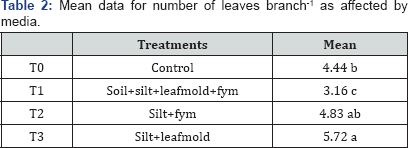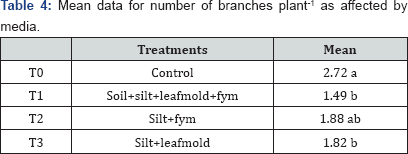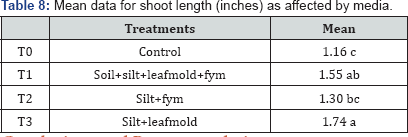Different Media Effect on Various Characteristics of Floribunda Rose (Rosa spp) - Juniper Publishers
Juniper Publishers- Open Access Journal of Environmental Sciences & Natural Resources
Different Media Effect on Various Characteristics of Floribunda Rose (Rosa spp)
Authored by Majid Hissam
Abstract
An experiment at Floriculture section of Agricultural Research Institute Tarnab Peshawar was carried out in 2016 to study the effect of soil, silt, leaf mold and FYM on various characteristics of Floribunda rose (Rosa Day Breaker) such as days to 50% sprouting, number of leaves plant-1, number of branches, number of leaves per branch, number of buds, callus diameter (inches), shoot diameter (cm), and shoot length (inches).The experiment was laid out in Randomized Complete Block Design (RCBD) with four treatments and three replications. Number of leaves branch-1, number of branches plant-1, callus diameter (inches), shoot diameter (cm) and shoot length were significantly affected by media, while no significant effect of media was recorded on days to 50 % sprouting, number of buds and number of leaves.
Keywords: Floribunda; Media; (RCBD); Replications; Treatments
Introduction
Rose, a symbol of affection, elegance, inspiration, sensuality, spirituality and source of aesthetic gratification for human beings, is one of the leading cut flowers in global floriculture trade. It belongs to genus Rosa of family Rosaceae, which contains 200 species and more than 18,000 cultivars [1]. It has always been the most favorite flower in the subcontinent. There is hardly any event where roses are not displayed in varied fashion. Cut rose flowers play an important role in interior decoration and add charm to different social and cultural ceremonies. Pakistan, being an agricultural economy, with diverse agro climatic a condition has a great potential for cut rose production. According to a survey, roses are being grown as cut flowers on 1,300 acres of land in Punjab [2] and an increase is being witnessed in rose cultivation in Pakistan. However, the technology being used is primitive which is a major hurdle in flourishing this industry in the country. Therefore, there is dire need to standardize production and handling technology for getting higher yields of better quality to compete in international markets. For this purpose, optimization of growing substrate is important as the substrates play a vital role in quality flower production. Various soilless substrates have successfully been used for several decades to intensify production and reduce cost [3].
These substrates have marked influence on plant’s health and vigor by dint of their role as a basic medium. A light, rich, porous and well drained medium is considered ideal for roses. Higher yield of best quality stems is entirely based on physico-chemical characteristics of growing substrates. Moreover, the fact that roses, unlike most other crops, are being constantly harvested and thereby exhibiting large fluctuation of the transpiring area must be taken into consideration when attempting to select a growing medium [4].
Studied that soilless cultivation of roses grown in perlite/ coconut coir dust increased yield and stem quality which might be related to the higher water holding capacity and cation exchange capacity of coconut coir, suggesting this organic material as one of the alternatives to peat for hydroponic culture. Cultivation of roses in soilless substrates is being practiced by using sand culture and nutrient flow technique (Takano, 1988); gravel culture [5]; organic substrates, mineral wool and aeroponics [6,7] and perlite [8]. There is a continuing interest in using various agricultural by products as an organic nutrient source for plants on account of their easy availability at cheaper prices and higher, slow release nutritional constituents [9,10].
Keeping in view the socio economic value of cut roses and emerging needs to standardize the technology for commercial rose production, this study was conducted with the objective to standardize growing substrate for cut rose production by incorporating easily available agricultural byproducts. A better understanding regarding the effectiveness of various growing substrates in improving growth, yield, manipulating soil characteristics and nutrient uptake would help to recommend a medium to the industry for quality rose production.
Materials and Methods
To study the effect of different growing media on floribunda rose (Rosa Day Breaker). An experiment was conducted at Floriculture section of Agricultural Research Institute Tarnab Peshawar in 2016. The experiment was laid out in Randomized Complete Block Design (RCBD) with four treatments and three replications.
a) Cuttings: 7-8 inches cuttings were taken from floribunda rose through sharp scissors.
b) Media preparation: The potted media was thoroughly prepared before the planting of rose cutting with the help of spade. Four different types of media soil, silt, leaf mold, FYM and the fifth one control were used.
c) Plastic bags: After media preparation plastic bags of 6 inches was filled from the media. In the bags rose cuttings was planted at a depth of 2-3 inches.
d) Irrigation and weeding: First irrigation was given just after plantation and then the cuttings were irrigated after specific interval of time through fountain. Weeds were removed manually.
e) Parameters studied: The following parameters were studied in the experiment.
a) Days to 50 % sprouting: Days to 50 % sprouting was counted from date of sowing.
b) Number of leaves plant-1: Number of leaves plant-1 was recorded by randomly selecting few plants from each treatment and then the average was calculated.
c) Number of branches plant-1: Number of Branches plant-1 was recorded by randomly selecting few plants from each treatment and then the average was calculated.
d) Number of leaves branch-1: Number of leaves Branch-1 was recorded by randomly selecting few plants from each treatment and then the average was calculated.
e) Number of Bud's plant-1: Number of Bud's plant-1 was recorded by randomly selecting few plants from each treatment and then the average was calculated.
f) Callus Diameter (inches): For callus diameter determination six plants was randomly selected in each treatment, diameter was determined through vernier caliper and then average diameter was calculated.
g) Shoot Diameter (cm): For shoot diameter determination six plants was randomly selected in each treatment, diameter was determined through vernier caliper and then average diameter was calculated.
h) Shoot length (inches): Shoot length was calculated through measuring tape by randomly selecting few plants from each treatment and then the average was calculated.
Statistical Procedure
The data were collected on different parameters and subjected to analysis of variance (ANOVA) using statistical package statistix 8.1. Least significant difference (LSD) test was used for finding significant differences between the means in case of significant results (Table 1).

Results and Discussion
a) Days to 50% sprouting: ANOVA regarding days to 50 % sprouting shows that media had no significant effect on days to 50 % sprouting [11]. Also found that media had no significant effect on days to 50 % sprouting.

b) Number of leaves branch-1: ANOVA regarding number of leaves branch-1 shows that number of leaves plant-1 was significantly affected by media. Mean data in (Table 2) shows that significantly highest number of leaves branch-1 were recorded for T3 and T2 followed by control while least number of leaves plant-1 were noted for T1[12,13]. Also found that media had significant effect on number of leaves branch-1. ANOVA regarding number of leaves plant-1 shows that media had no significant effect on number of leaves plant-1 [14]. Also found that media had no significant effect on number of leaves plant-1.
c) Number of branches plant-1: ANOVA regarding number of branches plant-1 shows that of branches plant-1 was significantly affected by media. Mean data in (Tables 3 & 4) shows that significantly highest number branches plant-1 were recorded for control and T2 followed by T3 while least number of branches plant-1 was noted for T1 [15]. Also found that media had significant effect on number of branches plant-1.


d) Callus Diameter (inches): ANOVA regarding callus diameter (inches) shows that callus diameter (inches) was significantly affected by media.Mean data in (Tables 5 & 6) shows that significantly highest callus diameter (inches) were recorded for T3 and control followed by T1 while least callus diameter (inches) were noted for T2 [16]. Also found that media had significant effect on callus diameter (inches).


e) No of buds: ANOVA regarding No of buds per plant shows that media had no significant effect on No of buds per plant [17]. Also found that media had no significant effect on No of buds.
f) Shoot diameter (cm): ANOVA regarding shoot diameter (cm) shows that shoot diameter (cm) was significantly affected by media. Mean data in Table 7 shows that significantly highest shoot diameter (cm) were recorded for T3 and T1 followed by T2 while least shoot diameter (cm) were noted for control [18]. Also found that media had significant effect on shoot diameter (cm).

g) Shoot length (inches): ANOVA regarding shoot length (inches) shows that shoot length (inches) was significantly affected by media. Mean data in (Table 8) shows that significantly highest shoot length (inches) were recorded for T3 and T1 followed by T2 while least shoot length (inches) were noted for control [18]. Also found that media had significant effect on shoot length (inches) [19-31].

Conclusion and Recommendation Conclusion
a) From the experiment it is concluded that media had significant effect on callus diameter (inches), shoot length (inches), shoot diameter (cm), number of branches and number of leaves per branch while non significant effect of media was noted for days to 50% sprouting, number of leaves per plant and number of buds.
b) The combination of silt and leaf mold gave us best result as compared to other treatments, so this combination is recommended for floribunda rose.
For more articles in Open Access Journal of Environmental Sciences & Natural Resources please click on: https://juniperpublishers.com/ijesnr/index.php




Comments
Post a Comment